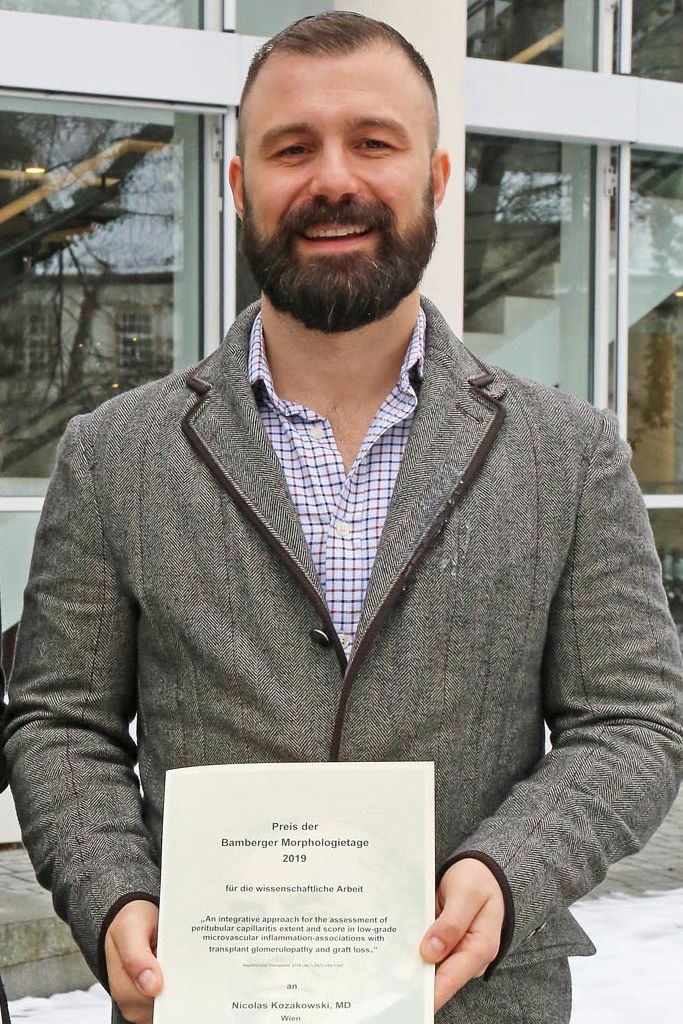
(Vienna, 31 January 2019) Nicolas Kozakowski from MedUni Vienna's Department of Pathology was awarded the science prize named after Johann Lukas Schönlein at Bamberger Morphologietage 2019. This prize recognises his papers about the relevance of accurately describing one of the most important lesions for the diagnosis of Antibody-Mediated Rejection (ABMR) of allografts – peritubular capillaritis.
The prize takes its name from Johann Lukas Schönlein, born in Bamberg in 1793, who is regarded as the greatest doctor in the history of Bamberg, having been an internist, medical historian, palaeobotanist and pathologist.
ABMR is the major cause of transplant loss in long-term survival and is the focus of intensive collaboration between scientists from clinical and diagnostic disciplines at the Medical University of Vienna, with the aim of improving detection, optimising treatment and ultimately prolonging transplant survival.
According to international recommendations from the Banff Foundation, an international expert consensus group, peritubular capillaritis is an important diagnostic criterion for ABMR, in terms of pathology. The primary aim of this expert group is continuous improvement of the pathological evaluation of rejection through the definition of histological lesions and the drafting of diagnostic guidelines. There has never been any detailed analysis of the significance of the extent and/or distribution of peritubular capillaritis or the composition of infiltrating leucocytes in allograft biopsies. This absence motivated N. Kozakowski to look at the morphology of peritubular capillaritis.
Working in collaboration with Željko Kikić from the Division of Nephrology and Dialysis (Department of Medicine III), he published three studies about the precise morphological properties of this inflammation. In a large general population of kidney-transplant patients (more than 700 patients and 1,300 kidney transplant biopsies) the diffuse extent of peritubular capillaritis was identified as an independent risk factor of the score used thus far for diminished long-term organ function and transplant loss and was published in Kidney International (IF: 8,428) together with an honourable commentary from internationally recognised nephropathologist Lorraine Racusen. This paper won the Austrian Society of Pathology’s Hans Popper Prize 2015.
This was followed by a paper published in the journal "Transplantation" (IF: 3,960), focusing on a risk population of patients with increased probability of ABMR. Here, the diffuse extent of peritubular capillaritis correlated with the binding forces of donor-specific circulating antibodies, which are regarded as a direct major cause of ABMR, and with mostly irreversible chronic lesions of the renal corpuscles inter alia (transplant glomerulopathy), a late change associated with protracted exposure of the transplanted organ to harmful antibodies. A poster of this paper was awarded the Michael J. Mihatsch & Dusan Ferluga Award by the Nephropathology Working Group of the European Society of Pathology.
Finally, the diagnostic advantage of this additional morphological information (diffuse extent of peritubular capillaritis) was evaluated. This study, which was included in "Nephrology, Dialysis and Transplantation" (IF: 4,600) showed that isolated, low-grade and diffuse peritubular capillaritis (ptc1diffuse), which is not currently regarded as diagnostically relevant, is nonetheless significantly associated with transplant glomerulopathy and poorer graft survival. The inclusion of this lesion in the Banff Foundation's currently accepted diagnostic criteria for ABMR significantly improved the prediction of subsequent transplant glomerulopathy and loss. These additional arguments in favour of the sound usefulness of accurate assessment of this histological feature support its value as a potential surrogate for the current antibody-mediated response of the body to the transplanted organ. The diffuse extent of peritubular capillaritis should be verified in an (ideally) international, multi-centre study under the aegis of the Banff Foundation and incorporated into the diagnostic recommendations.
About Nicolas Kozakowski
Nicolas Kozakowski studied human medicine at the Faculté de Médecine Xavier Bichat Paris VII. He works as a consultant in MedUni Vienna's Department of Pathology and is a member of the Nephropathology Working Group (with H. Regele, R. Kain and J. Kläger). His scientific focus is renal pathology and he has already published many papers in leading journals about the pathology of kidney transplant rejection, some of them in collaboration with colleagues from the Department of Medicine III, Division of Nephrology and Dialysis. He is currently in Paris for a research placement in the INSERM research unit of the Department of Nephrology led by Christos Chatziantoniou (previously by Pierre Ronco) and is studying complement inhibition in glomerular inflammation of the native kidney.
Bibliography
Kozakowski N, Herkner H, Bohmig GA, et al. The diffuse extent of peritubular capillaritis in renal allograft rejection is an independent risk factor for graft loss. Kidney Int 2015;88:332-40.
Kozakowski N, Eskandary F, Herkner H, et al. Diffuse Extent of Peritubular Capillaritis in Late Antibody-Mediated Rejection: Associations With Levels of Donor-Specific Antibodies and Chronic Allograft Injury. Transplantation 2017;101:e178-e87.
Kozakowski N, Herkner H, Eskandary F, et al. An integrative approach for the assessment of peritubular capillaritis extent and score in low-grade microvascular inflammation-associations with transplant glomerulopathy and graft loss. Nephrol Dial Transplant 2018.